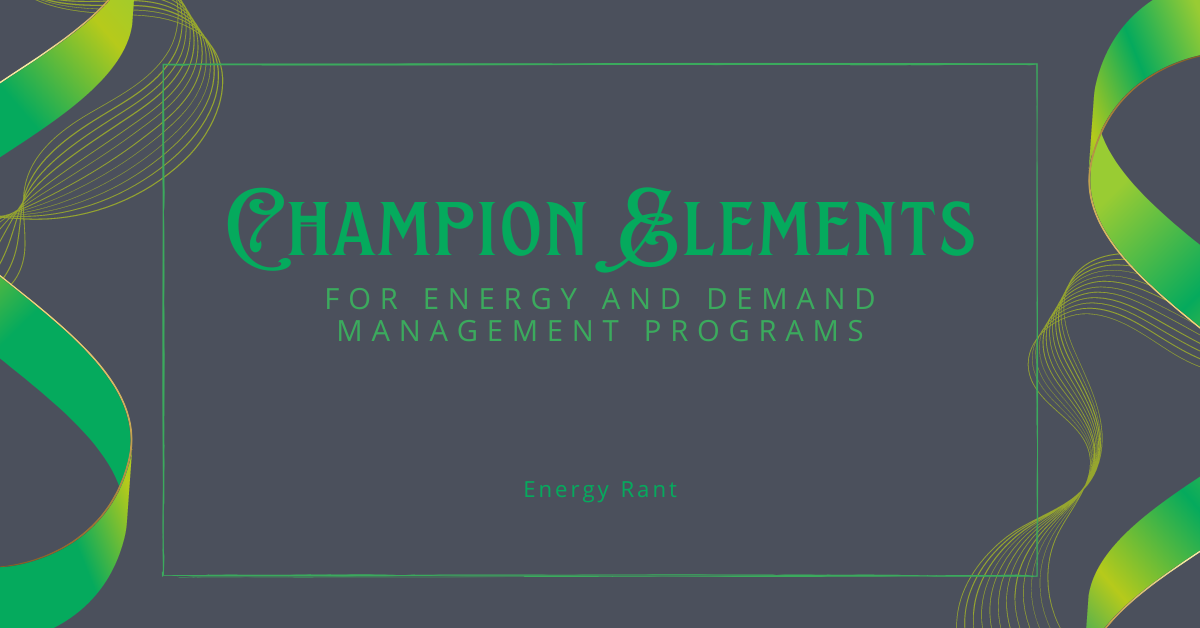
This is the finale of better than best commercial and industrial program practices – including a summary cheat sheet for program administrators.
Energy Analyses
Utilities want to build efficiency businesses in their service territories, which is very important. However, few service providers, designers, or contractors are proficient with energy calculations, especially for complex measures. Moreover, they don’t live in our goofy world of arbitrary baselines and will likely determine actual savings or some other goalposts to give their project a better shine.
If you have reviewed papers, articles, or maybe some reports, you know what I mean when I say, “this cannot be salvaged.” It would be better just to start over. The same thing goes for energy calculations. Do it once and declare victory. Do not have someone else do it and do it again on the program side. That is scorched earth.
If service providers want to do these calculations, they should be allowed to, but they need an overview of the hows and whys for savings calculations per regulated rules. Do not encourage or require them to provide calculations. Doing so wastes time and money and delivers a bad experience.
Focus on Strengths, Passions, Desires
This one is a cousin to the previous practice. There is plenty of work to be done. Let program actors focus on what they do best. Many contractors, whether controls, mechanical, electrical, or service entities like architects and engineers, just want to do the work. They are not interested in investigations, audits, or energy calculations. This especially applies to retro-commissioning and other operations and maintenance-related programs.
Providing what customers and market actors want and need delivers an excellent program experience by meeting those stakeholders where they are and providing what they need. A unisize program will fit well with about a quarter of service providers. The only thing we at Michaels won’t do is the project itself.
Collaborative Partnerships
Some program administrators (utilities) hire consultants to design their programs and portfolios, but those consultants (people), and sometimes their entire company, do not implement programs. Other utilities develop an entire portfolio like a 500-piece puzzle.
Whoa, whoa, whoa! Hooooold on thar, cowboy! A railroad program design can be anything from suboptimal to doomed. I have witnessed both. The implementation contractor should be allowed to collaborate with the program administrator to incorporate all lessons learned – from other jurisdictions and administrators to unique elements for the specific customer and market actor base. We call this a collaborative partnership, one of our values and how we do business.
End with the Beginning
Good evaluators are like good referees – they are not noticed and don’t take over the game or throw it. Remember that pass interference (not) call in the playoff game between the Saints and the Rams? Don’t be that evaluator.
Market transformation programs can require unique approaches to evaluation. They often need something called a market or baseline study to determine the baseline (standard practice), and then savings are determined relative to that market baseline. Well, the market study can cost a billion dollars and take three years. We want to start now with something we know will save a lot of energy. Some favorite Rants on code compliance include:
- Building Energy Codes – A Blutonian D-
- Outcomes Rather than Compliance – One Piece at a Time
- Energy Code Noncompliance – Could it be Satan?
- Energy Codes Bahahaha – You’re Killing Me
- Code Compliance Setup – A Boiler Project
- Indestructible Code Compliance Villains
- Specious Beliefs in the Code Gods
I suggest creativity. Do we need a billion-dollar market study to calculate defensible savings? No. Defensible savings can be achieved as the program progresses, and at the same time, standard practice can be determined. In the time and with the budget a baseline study is completed, a program can deliver GWh of savings and determine the standard practice baselines.
Review
In four posts, we covered fourteen champion practices for program design for the next generation of portfolios. For your printable summary, click here.
|
Better than Best Practice |
The Scoop |
|
| 1 | Downstream Needs to Go | Nominal cash incentives to residential and small commercial customers after the sale provide little motivation and are a hassle. However, aggregated in the midstream or upstream market actors can make a big difference by stocking efficient equipment only. |
| 2 | Information and Services | Like the previous practice, large C&I customers need intervention ahead of projects to plan and implement efficiency. They are more logical and objective and will do the right thing with good information. |
| 3 | Precision Bomb Barriers | Decisions or heavy influence usually occur upstream of the customer. Wholesalers, designers, and contractors are profit motivated to do what they always do at the lowest possible cost. Programs must address these actors rather than customers. |
| 4 | Leverage Dollars | Rather than finding $1 million in financing on the market and getting a $100,000 incentive, customers could use zero-interest financing using the $100,000 financed through the utility. Leverage. |
| 5 | Regulatory Reform | Regulatory bodies must view efficiency as a resource and allow utilities to monetize their programs by earning the weighted cost of capital on financed customer efficiency projects. It’s direct and more accessible than traditional cost recovery mechanisms and bonuses. |
| 6 | Transform a Market | For lasting outsize results, teach the market actors to fish rather than giving fish to customers. We don’t need stricter codes, higher equipment efficiencies, and impossible design and control requirements. We need simpler systems and collaboration with market actors for the best results. |
| 7 | Implementation Contractors | Information and service-related programs that intervene in the market usually require lots of technical, programmatic, and market knowledge. Program concepts may be strong, but implementation contractors may lack the necessary expertise and execution. Don’t give up on great ideas! |
| 8 | Accountability | Pay for performance is the rage today. State the key performance indicators and let the responsible implementation contractor own them. They cannot be accountable for disinterested parties injected into the process. |
| 9 | Custom Efficiency First (C&I) | For commercial and industrial customers, custom efficiency projects should significantly leverage program dollars to upsell systematic efficiency compared to small incremental gains in component efficiency. Therefore, custom should be the first choice, with prescriptive as a last resort. |
| 10 | No Opt-Outs | Some states lose nearly half their program budgets by allowing larger customers to opt-out of programs. Knowledge, interest, and expertise in efficiency run the gamut from residential to large manufacturing. All sectors must contribute and participate. |
| 11 | Energy Analyses (Custom) | Energy analyses are complex, especially when program portfolio rules are applied. Save money, improve equity, and streamline the process and evaluation activities by having implementation contractors handle these nuances. |
| 12 | Strengths, Passions, Desires | Every entity has its passion and purpose in business. Let the business focus on what they do best and allow programs to fill gaps in expertise, need for time, and interest. |
| 13 | Collaborative Partnerships | Implementation contractors and program administrators each bring unique perspectives to the table. Allow for innovative approaches and collaborate on details for the final program design. |
| 14 | The Good Ref, Evaluators | Evaluators can stifle innovation by forcing status quo methods onto unique, tightly budgeted program designs. Unique and innovative programs often require unique and innovative evaluation practices. Work with us! |




